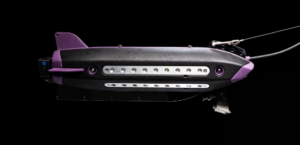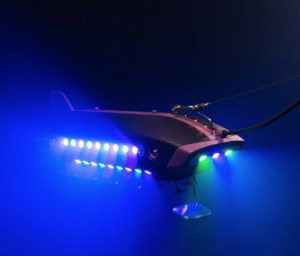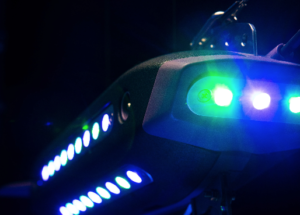The Gameraiser is a multifunctional teaser:
The Gameraiser represents a BaitBall, mimics a big cluster of fleeing baitfish. The flash and vibration generated by the Teaser creates multiple frequencies to attract game fish. The strategic design allows the frame to be pulled through hard cover and penetrate deeper into ambush territory. The Interchange System makes it easy to change colour patterns with a bottom.
Drift Teaser
The Game Raiser is not just a towable teaser. It can be used as a drift teaser when live baiting or chunking. Attach a keel weight and float to the teaser to manage the preferred depth.
Mooring Light
Attach the Game Raiser to a Game Raiser mooring bracket (an optional accessory) and lower it into the water to use as a mooring light by activating the solid-state (torch) mode. In addition, Game Raiser serves as a bait light to attract baitfish and squid at night.
The primary focus for the product started with Billfish, however, as the development process furthered and through testing, the results have shown that nearly all marine game fish species have been attracted into the spread with the Game Raiser. In the section below you can learn some of the fascinating facts about eyesight and vision of marlin and other game fish that helped us in developing the Game Raiser. The information is condensed from the commissioned paper “Seeing the Light” by Dr Julian Pepperell.
Can marlin see color?
Short answer: Yes, but they can only see the full spectrum of colors when they are within a few metres of the sea surface.
The earliest studies on this topic were carried out in the late 1970s by Japanese scientists aboard commercial longline vessels. Several billfish and tuna species were caught, their eyes immediately dissected out and their optic nerves hooked up to cathode-ray oscilloscopes. Pure-colored beams of light covering the whole visible spectrum were then shone onto the retinas and the screens indicated whether a response was triggered or not.
The results were quite consistent for all of the species tested (blue and black marlin, yellowfin and bigeye tuna and albacore). The conclusion was that the only colors these fish could see were greens, blues and purples. This finding was widely accepted until the late 1990s when a research team from the University of Queensland, Australia – Professor Jack Pettigrew, Dr Justin Marshall and Dr Kerstin Fritsches – showed renewed interest in these questions. Professor Pettigrew had been out on a charter boat off the Sunshine Coast and had watched closely as several sailfish and black marlin were tagged and released.
What fascinated him was the lighting-up and flashing colors of these fish when excited.Did this mean that billfish could perhaps see a wider color spectrum than was believed at the time? Thus began a decade-long series of ground-breaking experiments and studies primarily by Dr Kerstin Fritsches. With the help of gamefish anglers in Australia and Hawaii, she was able to obtain fresh eyes from several billfish species.
The question of whether marlin can see ultraviolet light was answered surprisingly quickly. Dr Fritsches dissected the lens from the eye of freshly caught black marlin landed at Port Stephens, Australia. Marlin lenses are transparent spheres, just like little crystal balls, and when she shone lights of various pure wavelengths through the lenses, her equipment showed that ultraviolet light was completely blocked, proving in that instant that they could not possibly see that part of the color spectrum.Dr Fritsches speculated that a possible reason for the lens blocking ultraviolet is that those wavelengths would be scattered by particles (plankton) in the upper layer of the ocean and penetrate for longer distances than other wavelengths. Therefore, blocking those from reaching the retina may allow marlin to see further than would otherwise be the case. This would presumably also apply when marlin at depth look up into illuminated water.
Dr Fritsches then turned her attention to the big question. Can billfish see color as we do? She dissected more marlin eyes, finding that their retinas contained not only cells called rods – which can only detect black, white and grey – but excitingly, two different types of cone cells which in other animals indicate color vision. But how does that finding sit with the earlier Japanese work suggesting limited color vision? Remarkably, it turns out that the retina of billfish is not uniform with respect to the distribution of color-sensing cone cells. In fact, the area packed with cone cells is on the bottom of the retina, meaning that full color can only be seen when the billfish is looking up into the light, not when it is looking down. It therefore seems likely that the original Japanese researchers had shone light onto the part of the retina that cannot see full color. The illustration below shows a comparison of the possible visual color sensitivities of a number of pelagic species – Marlin, swordfish, bigeye tuna and green turtle. It is best when looking at this figure to focus on the span of light colors in the ‘box’ for each. (From Fritsches 2007)
We Tag Cabo Sportfishing are proud and more than happy to be testing the Gameraiser prototype and so far we have been getting great results while fishing with it. We can’t hardly wait to see the final wireless product.
Starting 2023 we will be selling the product at our official Tag Cabo Sportfishing store in Cabo San Lucas.



